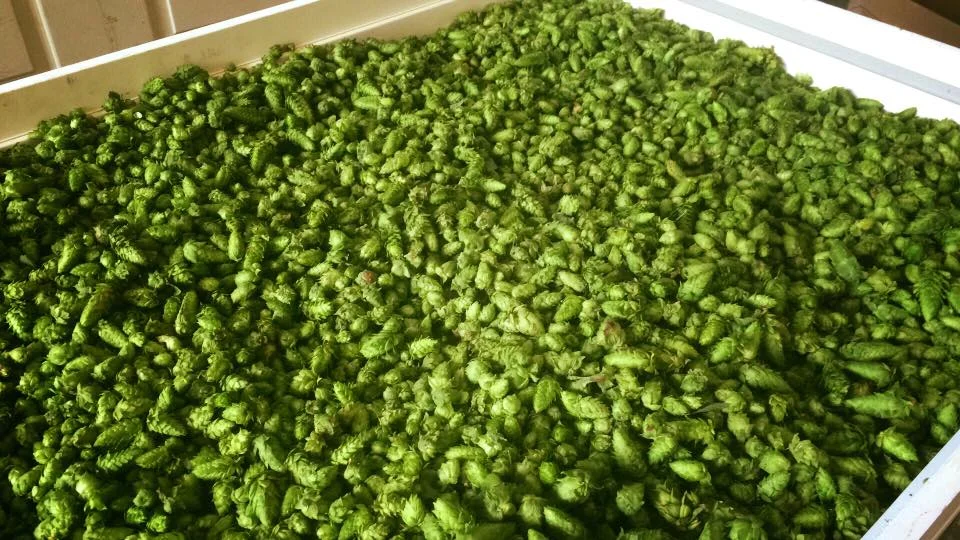“The existence of craft brews really is a marker of a town that's on the rise," says James Fallows, co-author of the book Our Towns: A 100,000-Mile Journey into the Heart of America. Fallows explains his statement by pointing out all the jobs breweries create: over 135,000 in breweries and pubs alone in 2017. For each of these jobs, adjacent industries, like the restaurants that feed bar-goers and the merchandisers who make breweries’ souvenirs, gain 31 additional jobs. For rural communities, breweries contribute even more deeply, promoting regional agriculture, strengthening the entrepreneurial ecosystem, and providing an amenity that is attractive to visitors and increases the quality of life for residents.
Sign for Dublin Corners Brewery in Linwood, NY.
In New York State, the Farm Brewery Law has been instrumental in getting craft breweries off the ground and increasing the state’s production of hops, barley, and other ingredients used to make beer and cider. Heather and Justin Grant were avid home brewers living on their fifth generation family farm in Linwood and growing their own hops when the state passed the law in 2012. Suddenly, brewers did not need any additional permits to sell their beers or ciders so long as the beers met minimum requirements for featuring local hops, barley, and other ingredients (according to the schedule for this license, the beer must contain a greater proportion of local ingredients as the years go on, until ultimately in 2024 the beer must consist of 90% New York State products). Craft brewers could sell their beer at markets, open restaurants, and avoid paying annual fees to the State Liquor Authority. Sensing a huge opportunity, the Grants got to work and opened a brewery in their barn in 2016, naming it Dublin Corners, the first brewery in Livingston County. With the state making these incentives dependent on the use of local agriculture, there are now an estimated 400 acres of hops in New York State -- up from around zero in 2000.
Local food on offer at Silver Lake Brewing Project in Perry, NY.
Breweries are, by nature, a very collaborative industry, since visitors to breweries are often expecting more than just beer. Breweries have to source food for their guests, so they bring in local food trucks or call upon nearby restaurants to deliver to their bar. Silver Lake Brewing Project in Perry, for instance, serves meals from the restaurant the Hole in the Wall, offers cheese plates from East Hill Creamery, and sells potato chips from NY Chips -- all food businesses that operate within the brewery’s county. Breweries licensed under the Farm Brewery Law are able to sell New York wines and ciders without any additional red tape, so when Dublin Corners opens its Geneseo taproom at the end of September, the business will be selling the wine and cider of other local companies.
Other People’s Pints, a festival at Rising Storm Brewing Co. in 2019.
The Livingston County Economic Development Office developed the Brew IN Livingston competition in 2016 in order to create a craft beer trail, providing four contestants with access to $35,000 in grant money, $100,000 in loans, and business help from the Livingston County Area Chamber of Commerce and Tourism and the New York State Brewers Association. This competition ultimately led to the Livingston Libation Loop, creating a community among local breweries, wineries, and cideries. One of the winners, Rising Storm Brewing Co. in Avon, now sell crowlers from OSB cider, a Livingston county cidery, and even hosted an event in July called Other People’s Pints (OPP), featuring 15 local breweries and multiple food trucks. Breweries are not just creating business for themselves, but giving work to everyone from the food truck chef to the musicians that play brewery events to transportation companies that take guests home after their brewery visits.
Community gathering at No BS Brew Company in Livonia, NY.
Breweries make places better destinations for visitors and better communities for residents. The Center on Rural Innovation in Vermont, leaders in rural development, includes breweries in their new mapping tool as one of the key indicators for rural communities with the assets needed to attract new tech jobs. As tourists progressively seek more immersive travel experiences, they look to breweries and restaurants to provide them with the authentic tastes of the places they are visiting. Craft beer trails are popping up all over the country as more and more people become willing to travel to explore new beers.
Local workers did all the renovation work at Battle Street Brewery in Dansville, NY.
The inhabitants of the Genesee Valley have also rallied around their local craft beer scene. Silver Lake Brewing Project turned to their neighbors for fundraising when building out their brewery in 2015, some of whom became investors and managing partners in the business. When Dennis Boor and Doug Acomb, Brew IN Livingston winners, renovated the Dansville Mt. Morris depot (a stop on the now defunct Dansville & Mount Morris Railroad) to create Battle Street Brewery, they decided to use exclusively local companies and workers.
Over the past ten years, the number of craft breweries in the United States has grown markedly, and rural communities have not been immune to that growth. The Finger Lakes Beer Trail, for instance, consisted of 24 breweries in 2011 and had grown to 100 in 2017. As the breweries in rural areas multiply, especially in New York where lenient permit regulations are tied to using state produce, the demand for local ingredients increases, benefitting agricultural workers. The breweries reach out to other businesses to provide things to their customers they cannot -- food, music, games, transportation, etc. -- strengthening community ties and the region’s economic ecosystem. Residents gain a neighborhood amenity and an increasing number of tourists come to visit the area to partake in the brewery’s offerings, staying in local hotels, eating local food, and frequenting local attractions on their trips. When breweries set up shop in a town, the benefits ricochet throughout the region.






